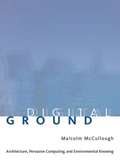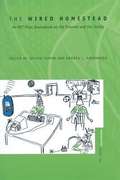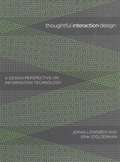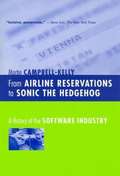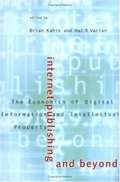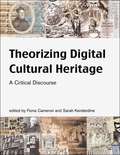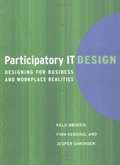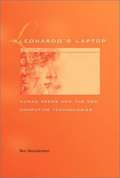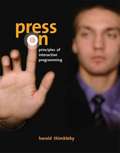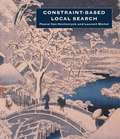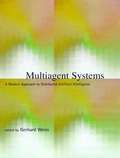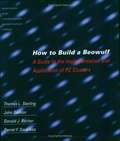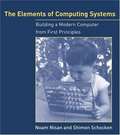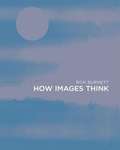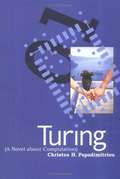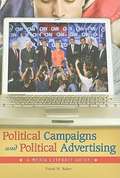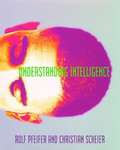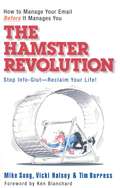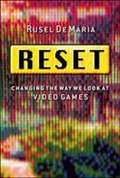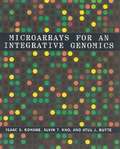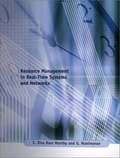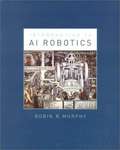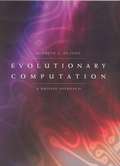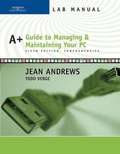- Table View
- List View
Digital Ground: Architecture, Pervasive Computing, and Environmental Knowing
by Malcom McclloughDigital Ground is an architect's response to the design challenge posed by pervasive computing. One century into the electronic age, people have become accustomed to interacting indirectly, mediated through networks.
The Wired Homestead: An MIT Press Sourcebook on the Internet and the Family
by Joseph Turow Andrea L. KavanaughThe use of the internet in homes rivals the advent of the telephone, radio, or television in social significance.
Half-Real: Video Games between Real Rules and Fictional Worlds
by Jesper JuulVideo games as both a departure from and a development of traditional games; an analysis of the interaction between rules and fiction in video games.
Thoughtful Interaction Design: A Design Perspective on Information Technology
by Jonas Löwgren Erik StoltermanThe authors of Thoughtful Interaction Design go beyond the usual technical concerns of usability and usefulness to consider interaction design from a design perspective. The shaping of digital artifacts is a design process that influences the form and functions of workplaces, schools, communication, and culture; the successful interaction designer must use both ethical and aesthetic judgment to create designs that are appropriate to a given environment. This book is not a how-to manual, but a collection of tools for thought about interaction design. Working with information technology--called by the authors "the material without qualities"--interaction designers create not a static object but a dynamic pattern of interactivity. The design vision is closely linked to context and not simply focused on the technology. The authors' action-oriented and context-dependent design theory, drawing on design theorist Donald Schon's concept of the reflective practitioner, helps designers deal with complex design challenges created by new technology and new knowledge. Their approach, based on a foundation of thoughtfulness that acknowledges the designer's responsibility not only for the functional qualities of the design product but for the ethical and aesthetic qualities as well, fills the need for a theory of interaction design that can increase and nurture design knowledge. From this perspective they address the fundamental question of what kind of knowledge an aspiring designer needs, discussing the process of design, the designer, design methods and techniques, the design product and its qualities, and conditions for interaction design.
From Airline Reservations to Sonic the Hedgehog: A History of the Software Industry
by Martin Campbell-KellyFrom its first glimmerings in the 1950s, the software industry has evolved to become the fourth largest industrial sector of the US economy. Starting with a handful of software contractors who produced specialized programs for the few existing machines, the industry grew to include producers of corporate software packages and then makers of mass-market products and recreational software. This book tells the story of each of these types of firm, focusing on the products they developed, the business models they followed, and the markets they served. By describing the breadth of this industry, Martin Campbell-Kelly corrects the popular misconception that one firm is at the center of the software universe. He also tells the story of lucrative software products such as IBM's CICS and SAP's R/3, which, though little known to the general public, lie at the heart of today's information infrastructure. With its wealth of industry data and its thoughtful judgments, this book will become a starting point for all future investigations of this fundamental component of computer history.
Internet Publishing and Beyond: The Economics of Digital Information and Intellectual Property
by Brian Kahin Hal R. VarianThe rapid growth of the Internet and the World Wide Web is transforming the way information is accessed and used. New models for distributing, sharing, linking, and marketing information are appearing. This volume examines emerging economic and business models for global publishing and information access, as well as the attendant transformation of international information markets, institutions, and businesses. It provides those in the public, private, and nonprofit sectors with a practical framework for dealing with the new information markets. Topics addressed include the effects of various technological factors and market environments on pricing; the relationship among classic production costs, transaction costs, and the economic value of intellectual property; the effects of different pricing practices for telecommunications and Internet services on the pricing of information; the bundling and unbundling of information services; changing cost structures and the allocation of rights among authors, publishers, and other intermediaries; the effects of markets for complementary products and services, including advertising, on the pricing and use of information; and policy implications of different pricing models. A Publication of the Harvard Information Infrastructure Project in Collaboration with the School of Information Management and Systems at the University of California at Berkeley.
Theorizing Digital Cultural Heritage: A Critical Discourse
by Fiona Cameron Sarah KenderdineIn Theorizing Digital Cultural Heritage, experts offer a critical and theoretical appraisal of the uses of digital media by cultural heritage institutions. Previous discussions of cultural heritage and digital technology have left the subject largely unmapped in terms of critical theory; the essays in this volume offer this long-missing perspective on the challenges of using digital media in the research, preservation, management, interpretation, and representation of cultural heritage. The contributors--scholars and practitioners from a range of relevant disciplines--ground theory in practice, considering how digital technology might be used to transform institutional cultures, methods, and relationships with audiences. The contributors examine the relationship between material and digital objects in collections of art and indigenous artifacts; the implications of digital technology for knowledge creation, documentation, and the concept of authority; and the possibilities for "virtual cultural heritage"--the preservation and interpretation of cultural and natural heritage through real-time, immersive, and interactive techniques. The essays in Theorizing Digital Cultural Heritagewill serve as a resource for professionals, academics, and students in all fields of cultural heritage, including museums, libraries, galleries, archives, and archaeology, as well as those in education and information technology. The range of issues considered and the diverse disciplines and viewpoints represented point to new directions for an emerging field. Contributors: Nadia Arbach, Juan Antonio Barcelo, Deidre Brown, Fiona Cameron, Erik Champion, Sarah Cook, Jim Cooley, Bharat Dave, Suhas Deshpande, Bernadette Flynn, Maurizio Forte, Kati Geber, Beryl Graham, Susan Hazan, Sarah Kenderdine, Jose Ripper Kos, Harald Kraemer, Ingrid Mason, Gavan McCarthy, Slavko Milekic, Rodrigo Paraizo, Ross Parry, Scot T. Refsland, Helena Robinson, Angelina Russo, Corey Timpson, Marc Tuters, Peter Walsh, Jerry Watkins, Andrea Witcomb Media in Transition series
Participatory IT Design: Designing for Business and Workplace Realities
by Keld Bodker Finn Kensing Jesper SimonsenThe goal of participatory IT design is to set sensible, general, and workable guidelines for the introduction of new information technology systems into an organization. Reflecting the latest systems-development research, this book encourages a business- oriented and socially sensitive approach that takes into consideration the specific organizational context as well as first-hand knowledge of users' work practices and allows all stakeholders--users, management, and staff--to participate in the process. Participatory IT Designis a guide to the theory and practice of this process that can be used as a reference work by IT professionals and as a textbook for classes in information technology at introductory through advanced levels. Drawing on the work of a ten-year research program in which the authors worked with Danish and American companies, the book offers a framework for carrying out IT design projects as well as case studies that stand as examples of the process. The method presented in Participatory IT Design--known as the MUST method, after a Danish acronym for theories and methods of initial analysis and design activities--was developed and tested in thirteen industrial design projects for companies and organizations that included an American airline, a multinational pharmaceutical company, a national broadcasting corporation, a multinational software house, and American and Danish universities. The first part of the book introduces the concepts and guidelines on which the method is based, while the second and third parts are designed as a practical toolbox for utilizing the MUST method. Part II describes the four phases of a design project--initiation, in-line analysis, in-depth analysis, and innovation. Part III explains the method's sixteen techniques and related representation tools, offering first an overview and then specific descriptions of each in separate sections.
Leonardo's Laptop: Human Needs and the New Computing Technologies
by Ben Shneiderman2003 IEEE-USAB Award for Distinguished Literary Contributions Furthering Public Understanding of the Profession. and Selected as a Finalist in the category of Computer/Internet in the 2002 Independent Publisher Book Awards (IPPYs) presented by Independent Publisher Magazine Ben Shneiderman's book dramatically raises computer users' expectations of what they should get from technology. He opens their eyes to new possibilities and invites them to think freshly about future technology. He challenges developers to build products that better support human needs and that are usable at any bandwidth. Shneiderman proposes Leonardo da Vinci as an inspirational muse for the "new computing." He wonders how Leonardo would use a laptop and what applications he would create. Shneiderman shifts the focus from what computers can do to what users can do. A key transformation is to what he calls "universal usability," enabling participation by young and old, novice and expert, able and disabled. This transformation would empower those yearning for literacy or coping with their limitations. Shneiderman proposes new computing applications in education, medicine, business, and government. He envisions a World Wide Med that delivers secure patient histories in local languages at any emergency room and thriving million-person communities for e-commerce and e-government. Raising larger questions about human relationships and society, he explores the computer's potential to support creativity, consensus-seeking, and conflict resolution. Each chapter ends with a Skeptic's Corner that challenges assumptions about trust, privacy, and digital divides.
Press On: Principles of Interaction Programming
by Harold ThimblebyInteractive systems and devices, from mobile phones to office copiers, do not fulfill their potential for a wide variety of reasons--not all of them technical. Press On shows that we can design better interactive systems and devices if we draw on sound computer science principles. It uses state machines and graph theory as a powerful and insightful way to analyze and design better interfaces and examines specific designs and creative solutions to design problems. Programmers--who have the technical knowledge that designers and users often lack--can be more creative and more central to interaction design than we might think. Sound programming concepts improve device design. Press On provides the insights, concepts and programming tools to improve usability. Knowing the computer science is fundamental, but Press On also shows how essential it is to have the right approaches to manage the design of systems that people use. Particularly for complex systems, the social, psychological and ethical concerns--the wider design issues--are crucial, and these are covered in depth. Press On highlights key principles throughout the text and provides cross-topic linkages between chapters and suggestions for further reading. Additional material, including all the program code used in the book, is available on an interactive web site. Press On is an essential textbook and reference for computer science students, programmers, and anyone interested in the design of interactive technologies.
Constraint-based Local Search
by Pascal Van Hentenryck Laurent MichelThe ubiquity of combinatorial optimization problems in our society is illustrated by the novel application areas for optimization technology, which range from supply chain management to sports tournament scheduling. Over the last two decades, constraint programming has emerged as a fundamental methodology to solve a variety of combinatorial problems, and rich constraint programming languages have been developed for expressing and combining constraints and specifying search procedures at a high level of abstraction. Local search approaches to combinatorial optimization are able to isolate optimal or near-optimal solutions within reasonable time constraints.This book introduces a method for solving combinatorial optimization problems that combines constraint programming and local search, using constraints to describe and control local search, and a programming language, COMET, that supports both modeling and search abstractions in the spirit of constraint programming.After an overview of local search including neighborhoods, heuristics, and metaheuristics, the book presents the architecture and modeling and search components of constraint-based local search and describes how constraint-based local search is supported in COMET. The book describes a variety of applications, arranged by meta-heuristics. It presents scheduling applications, along with the background necessary to understand these challenging problems. The book also includes a number of satisfiability problems, illustrating the ability of constraint-based local search approaches to cope with both satisfiability and optimization problems in a uniform fashion.
Multiagent Systems: A Modern Approach to Distributed Artificial Intelligence
by Gerhard WeissThis is the first comprehensive introduction to multiagent systems and contemporary distributed artificial intelligence that is suitable as a textbook.
How to Build a Beowulf: A Guide to the Implementation and Application of PC Clusters
by Thomas L. Sterling John Salmon Donald J. Becker Daniel F. SavareseSupercomputing research--the goal of which is to make computers that are ever faster and more powerful--has been at the cutting edge of computer technology since the early 1960s. Until recently, research cost in the millions of dollars, and many of the companies that originally made supercomputers are now out of business. The early supercomputers used distributed computing and parallel processing to link processors together in a single machine, often called a mainframe. Exploiting the same technology, researchers are now using off-the-shelf PCs to produce computers with supercomputer performance. It is now possible to make a supercomputer for less than $40,000. Given this new affordability, a number of universities and research laboratories are experimenting with installing such Beowulf-type systems in their facilities. This how-to guide provides step-by-step instructions for building a Beowulf-type computer, including the physical elements that make up a clustered PC computing system, the software required (most of which is freely available), and insights on how to organize the code to exploit parallelism. The book also includes a list of potential pitfalls.
The Elements of Computing Systems: Building a Modern Computer from First Principles
by Noam Nisan Shimon SchockenIn the early days of computer science, the interactions of hardware, software, compilers, and operating system were simple enough to allow students to see an overall picture of how computers worked. With the increasing complexity of computer technology and the resulting specialization of knowledge, such clarity is often lost. Unlike other texts that cover only one aspect of the field, The Elements of Computing Systems gives students an integrated and rigorous picture of applied computer science, as its comes to play in the construction of a simple yet powerful computer system. Indeed, the best way to understand how computers work is to build one from scratch, and this textbook leads students through twelve chapters and projects that gradually build a basic hardware platform and a modern software hierarchy from the ground up. In the process, the students gain hands-on knowledge of hardware architecture, operating systems, programming languages, compilers, data structures, algorithms, and software engineering. Using this constructive approach, the book exposes a significant body of computer science knowledge and demonstrates how theoretical and applied techniques taught in other courses fit into the overall picture. Designed to support one- or two-semester courses, the book is based on an abstraction-implementation paradigm; each chapter presents a key hardware or software abstraction, a proposed implementation that makes it concrete, and an actual project. The emerging computer system can be built by following the chapters, although this is only one option, since the projects are self-contained and can be done or skipped in any order. All the computer science knowledge necessary for completing the projects is embedded in the book, the only pre-requisite being a programming experience. The book's web site provides all tools and materials necessary to build all the hardware and software systems described in the text, including two hundred test programs for the twelve projects. The projects and systems can be modified to meet various teaching needs, and all the supplied software is open-source.
How Images Think
by Ron BurnettDigital images are an integral part of all media, including television, film, photography, animation, video games, data visualization, and the Internet. In the digital world, spectators become navigators wending their way through a variety of interactive experiences, and images become spaces of visualization with more and more intelligence programmed into the very fabric of communication processes. In How Images Think, Ron Burnett explores this new ecology, which has transformed the relationships humans have with the image-based technologies they have created. So much intelligence has been programmed into these image-dependent technologies that it often seems as if images are "thinking"; ascribing thought to machines redefines our relationship with them and enlarges our ideas about body and mind. Burnett argues that the development of this new, closely interdependent relationship marks a turning point in our understanding of the connections between humans and machines. After presenting an overview of visual perception, Burnett examines the interactive modes of new technologies -- including computer games, virtual reality, digital photography, and film -- and locates digital images in a historical context. He argues that virtual images occupy a "middle space," combining the virtual and the real into an environment of visualization that blurs the distinctions between subject and object -- part of a continuum of experiences generated by creative choices by viewers, the results of which cannot be attributed either to images or to participants.
Turing: A Novel about Computation
by Christos H. PapadimitriouThe world of computation according to Turing, an interactive tutoring program, as told to star-crossed lovers; a novel.
Political Campaigns and Political Advertising: A Media Literacy Guide
by Frank W. BakerBaker, a media literacy consultant and author, has written this media literacy guide for general readers who want more critical insight into propaganda and spin, political advertising and the role of new media technologies in election campaigns. The author uses clear and easy-to-understand language to examine and interpret the content of media messages in print, image and multimedia forms in an objective manner. The author supplies both a timeline of the history of media in politics from 1913 to the present and a glossary of political and media terms. Annotation ©2009 Book News, Inc., Portland, OR (booknews.com)
Understanding Intelligence
by Rolf Pfeifer Christian ScheierBy the mid-1980s researchers from artificial intelligence, computer science, brain and cognitive science, and psychology realized that the idea of computers as intelligent machines was inappropriate. The brain does not run "programs"; it does something entirely different. But what? Evolutionary theory says that the brain has evolved not to do mathematical proofs but to control our behavior, to ensure our survival. Researchers now agree that intelligence always manifests itself in behavior--thus it is behavior that we must understand. An exciting new field has grown around the study of behavior-based intelligence, also known as embodied cognitive science, "new AI," and "behavior-based AI." This book provides a systematic introduction to this new way of thinking. After discussing concepts and approaches such as subsumption architecture, Braitenberg vehicles, evolutionary robotics, artificial life, self-organization, and learning, the authors derive a set of principles and a coherent framework for the study of naturally and artificially intelligent systems, or autonomous agents. This framework is based on a synthetic methodology whose goal is understanding by designing and building. The book includes all the background material required to understand the principles underlying intelligence, as well as enough detailed information on intelligent robotics and simulated agents so readers can begin experiments and projects on their own. The reader is guided through a series of case studies that illustrate the design principles of embodied cognitive science.
The Hamster Revolution: How to Manage Your Email Before it Manages You
by Mike Song Vicki Halsey Tim Burress Ken BlanchardThe Hamster Revolution is a timely solution to both the widespread problem of email overload as well as most people's inefficient (or nonexistent) systems for categorizing and storing email messages.
Reset: Changing the Way We Look at Video Games
by Rusel DemariaIn this analysis of the increasingly violent and uncreative video gaming industry, author Rusel DeMaria offers a road map for parents, educators, gamers, and industry insiders to leverage the inherent potential of games to promote positive personal and social change.
Microarrays for an Integrative Genomics
by Isaac S. Kohane Alvin Kho Atul J. ButteFunctional genomics--the deconstruction of the genome to determine the biological function of genes and gene interactions--is one of the most fruitful new areas of biology. The growing use of DNA microarrays allows researchers to assess the expression of tens of thousands of genes at a time. This quantitative change has led to qualitative progress in our ability to understand regulatory processes at the cellular level. This book provides a systematic introduction to the use of DNA microarrays as an investigative tool for functional genomics. The presentation is appropriate for readers from biology or bioinformatics. After presenting a framework for the design of microarray-driven functional genomics experiments, the book discusses the foundations for analyzing microarray data sets, genomic data-mining, the creation of standardized nomenclature and data models, clinical applications of functional genomics research, and the future of functional genomics.
Resource Management in Real-Time Systems and Networks
by C. Siva Ram Murthy G. ManimaranReal-time systems and networks are of increasing importance in many applications, including automated factories, telecommunication systems, defense systems, and space systems. This book introduces the concepts and state-of-the-art research developments of resource management in real-time systems and networks. Unlike other texts in the field, it covers the entire spectrum of issues in resource management, including task scheduling in uniprocessor real-time systems; task scheduling, fault-tolerant task scheduling, and resource reclaiming in multiprocessor real-time systems; conventional task scheduling and object-based task scheduling in distributed real-time systems; message scheduling; QoS routing; dependable communication; multicast communication; and medium access protocols in real-time networks. It provides algorithmic treatments for all of the issues addressed, highlighting the intuition behind each algorithm and giving examples. The book also includes two chapters of case studies.
Introduction to AI Robotics
by Robin R. MurphyThis text covers all the material needed to understand the principles behind the AI approach to robotics and to program an artificially intelligent robot for applications involving sensing, navigation, planning, and uncertainty. Robin Murphy is extremely effective at combining theoretical and practical rigor with a light narrative touch. In the overview, for example, she touches upon anthropomorphic robots from classic films and science fiction stories before delving into the nuts and bolts of organizing intelligence in robots. Following the overview, Murphy contrasts AI and engineering approaches and discusses what she calls the three paradigms of AI robotics: hierarchical, reactive, and hybrid deliberative/reactive. Later chapters explore multiagent scenarios, navigation and path-planning for mobile robots, and the basics of computer vision and range sensing. Each chapter includes objectives, review questions, and exercises. Many chapters contain one or more case studies showing how the concepts were implemented on real robots. Murphy, who is well known for her classroom teaching, conveys the intellectual adventure of mastering complex theoretical and technical material.
Evolutionary Computation: A Unified Approach
by Kenneth A. de JongChoice Outstanding Academic Title, 2006. Evolutionary computation, the use of evolutionary systems as computational processes for solving complex problems, is a tool used by computer scientists and engineers who want to harness the power of evolution to build useful new artifacts, by biologists interested in developing and testing better models of natural evolutionary systems, and by artificial life scientists for designing and implementing new artificial evolutionary worlds. In this clear and comprehensive introduction to the field, Kenneth De Jong presents an integrated view of the state of the art in evolutionary computation. Although other books have described such particular areas of the field as genetic algorithms, genetic programming, evolution strategies, and evolutionary programming, Evolutionary Computation is noteworthy for considering these systems as specific instances of a more general class of evolutionary algorithms. This useful overview of a fragmented field is suitable for classroom use or as a reference for computer scientists and engineers.
Lab Manual for A+ Guide to Managing and Maintaining Your PC, Sixth Edition, Comprehensive
by Jean Andrews Todd VergeNIMAC-sourced textbook
